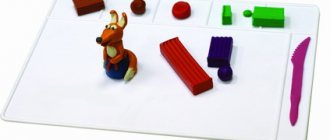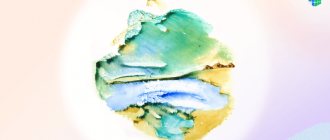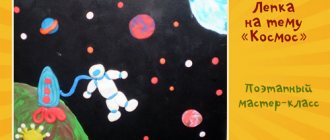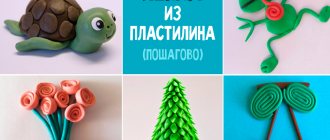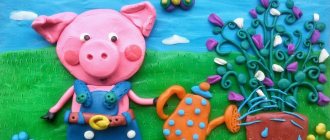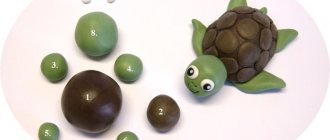What are the benefits of modeling
The human psyche continues to remain very poorly understood. Despite many discoveries and recommendations, it is impossible to make an exact statement in this area - you have to act by generalizations.
However, even according to statistics, plastic modeling has a beneficial effect on both the mental state of the child and his mental and neurophysiological development. The brain of a small person develops only if there is interaction with the outside world.
Children of modern civilization are largely protected from the natural world for safety reasons. Therefore, optimizing interaction is the main task of parents. The tactile sensations that a child receives from the tactile nerves are a powerful stimulating factor that provokes the brain to further development.
Expert opinion
Mikhailova Alevtina Petrovna
Child development teacher
Observations show that children who actively touch objects and play with them develop faster and more fully than those who are deprived of tactile sensations.
Modeling with plasticine, clay or dough is a wonderful exercise that triggers mechanisms for improving the child’s nervous system.
Development of coordination and fine motor skills
A newborn baby's nervous system is not yet strong; he makes many chaotic, “false” movements that are not aimed at performing a conscious action.
At the age of one year, movements become meaningful, but coordination has not yet been developed. The child learns to control his body, and his nervous system works out all sorts of combinations.
Modeling classes can significantly accelerate the development of fine motor skills. Fine motor skills are a combination of the muscular, nervous and visual systems for small operations with the fingers and hands.
At the Institute of Physiology of Children and Adolescents, it was proven that the projections of the hands are located near the speech centers, therefore the formation of fine motor skills contributes to the development of speech.
Children who regularly engage in modeling - first under the supervision of adults, and then independently - quickly master the necessary everyday skills: fastening buttons, holding and handling cutlery, holding a pen, pencil or brush, correctly assembling construction sets with small parts.
Development of spatial thinking and imagination
Plasticine is useful not only for babies, but also for older children. The desire to replicate the world around us in drawing or sculpture is already an example of higher nervous activity. With the help of modeling, mental and rational qualities are developed, an indirect, visual understanding of the physics of the real world occurs (thin things bend, fall without support, etc.).
Spatial imagination helps a child better navigate in this world, as well as develop his creative abilities.
Salty dough
This type of creativity was held in high esteem by our distant ancestors, who decorated pies and loaves with figures, braided ears of corn and berries. Even the smallest children can use the dough; the main advantage of this material is that it is completely safe and environmentally friendly.
You can prepare materials for crafts like this:
- take a glass of flour and salt, add ½ glass of very cold water, knead thoroughly until a homogeneous mass is formed;
- to the three previously described components add 2 tablespoons of sunflower oil or fatty glycerin cream.
You can knead the dough either by hand or with a mixer. The first option is suitable for creating small elements and details, while the second is ideal for larger-scale sculpting.
If a child has been modeling for a long time and has succeeded in this matter, you can prepare an improved version of the dough for him, which allows him to create more durable crafts and paint them. For this you will need:
- flour - 1.5 cups;
- salt (fine extra) – 1 glass;
- water – ½ cup;
- PVA or wallpaper glue - 2-3 tablespoons (can be done without glue).
This option allows you to create both large parts and small elements.
Types of materials for modeling
The baby products industry can offer modern parents a variety of products that can be used for modeling. A wide range of plastics includes both the material itself and play sets, which include molds, cutting tools and other related items.
Clay
The most ancient material for modeling. People learned to sculpt from clay even before the development of civilizations. This material is found everywhere, because it is a fine sedimentary rock. You can get it yourself, but it is much easier to buy it at a hardware store or art shop. To work, clay should be mixed with water and kneaded thoroughly - after this it acquires a viscous consistency.
After drying, the clay retains its shape. Unfortunately, it is impossible to produce ceramics—fired clay—at home; this requires a temperature of about 900° C. However, even products made from raw clay can be stored on a shelf for a long time, although they are fragile.
Lifehack. In order to imitate ceramic shine, the sculpted craft is treated with a layer of PVA glue. After drying, the product is covered with a film, which also improves mechanical strength.
True, clay is not suitable for small children - it intensively stains hands and everything around them, and in the process of evaporation of moisture it quickly hardens. But for boys and girls of school age, modeling with clay is already a serious creative process that introduces them to artistic culture.
Gypsum
This material is more suitable for casting rather than sculpting, allowing precise shapes to be achieved with low weight. However, even an infant can find it interesting and educational to leave prints in a trough with plaster.
Expert opinion
Mikhailova Alevtina Petrovna
Child development teacher
The advantage is that plaster products can be painted. The downside is that it dries very quickly.
In order to be able to sculpt with plaster by hand, it is better to purchase special dense sculptural plaster of a yellowish color - it is more flexible and takes longer to dry, but is not sold in construction stores.
Clay-based plasticine
One of the most famous materials of our time. Previously, plasticine was made from clay powder, to which wax, animal oils and powdered natural dyes were added.
Today, polymer compounds are used as additives to purified and bleached clay, which provide the composition with the necessary plasticity and allow it to retain its properties after a long time.
Classic plasticine based on clay (kaolin) is quite hard. Sometimes it is called “Soviet”, but here the difference is more in the composition than in the time of production. The fact is that at that time polymer compounds were not yet known in such quantities, and most importantly, they were not being introduced into the domestic sphere. Therefore, old-style plasticine has good adhesion within the mass and with foreign objects.
It is very dense, and therefore, before playing with it, an adult must knead and roll it out thoroughly. Only after this the kids will be able to sculpt something with their still weak hands.
The advantages of this material are its mechanical strength and adhesion. The man's head will definitely not fall off if it is connected well. The disadvantages are the need for preheating, as well as high soiling.
A well-known “Soviet” way to preserve freshly molded plasticine products is to place them in the freezer for a day. The object will become hard and, even after subsequent thawing, will not fall apart, but will become increasingly hard over time.
Polymer plasticine
Abroad, industrial technologies were used in folk goods as a means of making a profit. This is how polymer plasticine was invented - natural kaolin was replaced by plastic compounds with additives.
This made the material more flexible, homogeneous, and soft. During storage, it does not harden and requires almost no preheating. Its softness allows it to be used even by one-year-old children. Even if they don't make anything resembling the real thing, they can squish the clay in their hands and watch it change shape. It also develops the muscles of the fingers and hand well.
Polymer plasticine is not entirely safe for health. It will not cause acute poisoning, but can cause digestive upset. In addition, a child can simply choke on a large piece of plasticine or stick it up his nose. Therefore, up to 3 years of age, play only under parental supervision!
Today, polymer plasticine has many subtypes: ball, floating, wax and others. Thanks to special ingredients, the properties of plasticine can change: it can be lighter than water, become as sticky as possible, or, conversely, not stain your hands, table and clothes.
Modeling mass
And again polymers are in the service of humans for children's entertainment. Modeling mass differs from plasticine in that, after giving it a shape, it gradually hardens in air.
Depending on the composition, hardening can last up to half a day. All this time, changes can be made to the finished craft. True, the cost of a good mass is quite high. In addition, it is not reusable, which means you will have to buy it again and again.
Play dough
A material that has gained popularity quite recently. Play dough is so named because it resembles regular stiff dough made from flour. The famous Play-Doh brand says that their dough's main ingredients are flour, salt and water.
However, the full composition is kept secret. It is obvious that the outstanding characteristics of a mixture of natural products are given by the dyes and additives that prevent drying and preserve the product from spoilage.
The main feature of play dough is its low adhesiveness. By allowing the child to play with the dough, parents can be sure that the child will not get dirty himself or spoil the environment. Due to its natural composition, play dough is safe to swallow - up to certain limits, of course.
Expert opinion
Mikhailova Alevtina Petrovna
Child development teacher
Unfortunately, play dough has one major drawback - it dries out in the open air, so it should be kept in a tightly closed container.
Kinetic sand
You can also find the names “cosmic sand” because of the special properties compared to ordinary sand or “rainbow sand” because of the pigments, thanks to which the substance in jars and buckets acquires different colors.
Kinetic sand is specially selected fine quartz sand to which special polymer binders have been added.
They give the material special properties: being soft and “flowing” in a fluffed state, sand holds its shape well when compacted.
When compacted into molds, it leaves clear impressions that ordinary wet sand will never produce.
Sand is not called kinetic for nothing: the tactile sensations when playing with it have a calming effect.
Therefore, classes with him are recommended for children with mental disorders, hyperactive and nervous boys and girls. Little fidgets will be captivated by an exciting game for half an hour, or maybe more, giving adults the opportunity to get down to business.
The great advantage of “space” sand is its ability to retain its properties in the open air. Therefore, many parents, having filled the sandbox, no longer collect the plastic mass in a container or bucket.
However, with all the advantages, kinetic sand has its disadvantages or, more precisely, features:
- With long enough use, sand gradually absorbs moisture from children's palms, dirt and dust particles. After a few months of active play, it may begin to smell unpleasant and stick to your hands. This is a clear signal to completely replace the material, since it is impossible to clean it.
- The quality of sand greatly depends on the manufacturer. Considering that both unknown Chinese factories and venerable companies produce this product, one sample can retain its “silky” properties for months, while another begins to stick to your hands after just a couple of weeks of use.
In order for any modeling material to last longer, be more pleasant and functional, it is worth choosing products from trusted manufacturers. A higher price is a payment for the interest and health of the child over a long period of time.
Wax plasticine
Another great option for children's creativity. It is one of the varieties of ordinary plasticine, but is suitable for modeling by the youngest children - from one year old. Wax is used as the basis for its production, as the name suggests.
The benefits of wax plasticine include:
- Ease of use. Even a child’s weak hand will be able to roll a ball or sausage without any extra effort.
- Minimum additives, environmentally friendly and non-toxic. These factors are especially important when choosing material for children's creativity.
- Very good for training finger dexterity. At the same time, it is much softer than its classic “brother”, so the baby will like it much more, and working with it will not require preliminary warm-up.
- It will be much easier for your baby to create even a complex craft due to the increased stickiness of the mass. The elements “grab” without any extra effort.
- Bright colorful tones can improve your mood.
Parents should know that there are several types of wax plasticine, differing in the degree of softness. The choice is made according to a simple principle: the younger the child, the softer the plasticine.
Clay
Experts recommend using this material without fail, even in parallel with plasticine, since the clay is not colored and does not distract attention directly from the form. This pliable and soft material allows you to create a variety of figures, including dishes, people, and animals. Then they can be painted in bright colors to create an unusual composition. The key advantage of the material, which distinguishes it favorably from plasticine, is the ability to store the craft for a long time.
Next, we will consider several clay options for children's creativity.
Polymer
Sold in almost every art supply store, it is affordable, pliable, but becomes hard after baking. Available in a variety of colors, including bright ones, to suit your baby’s taste. No preliminary preparation is required - the material is already ready for use, all that remains is to sit down and start sculpting.
Please note that children should not be given the opportunity to work with clay unattended, since very few children will be able to avoid the temptation to put the bright substance in their mouth.
Natural
The first advantage is the absence of impurities and dyes. This is an environmentally friendly product, packaged in bags. And this is also its main drawback - the clay will need to be kneaded before work. Most often, ordinary gray clay is used, a soft and plastic material.
Not every child will be delighted with this natural material - polymer colorful options, as a rule, are liked much more by young sculptors. But this is everyone’s personal choice; someone may like the opportunity to first sculpt a figurine and then decorate it.
Craft options
Please note that the work will require not only material, but also some tools. These include:
- Board or mat for rolling out. It is not necessary to purchase expensive models; the main requirement is a flat surface.
- Stacks (sticks). They help cut a piece of plasticine into pieces, as well as make recesses in it. One or two plastic stacks are enough for a child.
- To add texture, you can purchase special texture sheets.
What can kids do? There are a lot of ideas, because, in addition to the above materials for modeling, you can use buttons, pebbles, shells, twigs, acorns and cones, autumn leaves, pine needles and much more.
The little ones can start by making a simple apple:
- Roll the plasticine in your palms until it forms a spherical shape.
- Use a stick to make a notch.
- Make a sheet from green plasticine.
Also easy to implement are fungus, tomato, and ladybug. An interesting craft is a hedgehog whose needles are made of toothpicks.
There are a large number of materials for modeling; it is very important not to limit the imagination and desire of children, but to give them the opportunity to do what they really like.
Soda mass
Check out another version of homemade plasticine. You will need the simplest available tools:
- soda – 1 glass;
- corn starch – ½ cup;
- warm water – ¾ cup.
Procedure:
- Combine starch and soda. Please note that it is also possible to use potato starch, but in this case the mass will be colored grayish and will not be snow-white.
- Add the bulk ingredients to the water and stir well.
- Place the container on moderate heat
- Cook until thickened, stirring constantly.
- When the mass looks like a single lump, turn off the gas and cool slightly.
- After this, knead.
The resulting “homemade plasticine” is ideally suited for children’s creativity.
